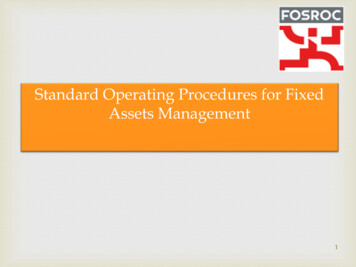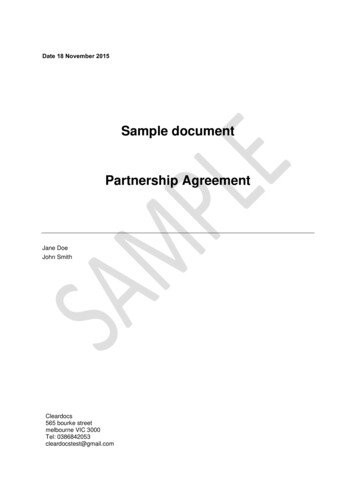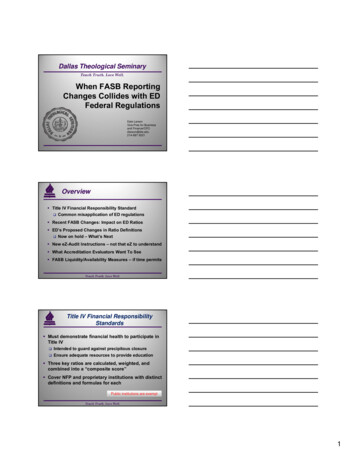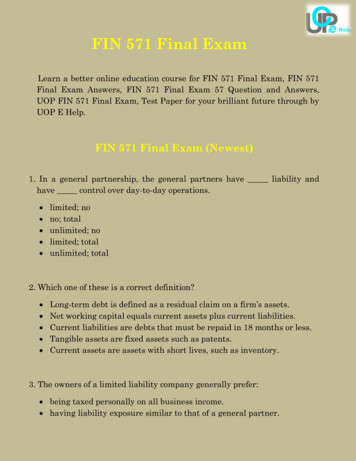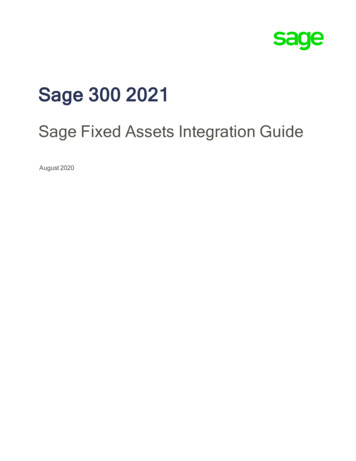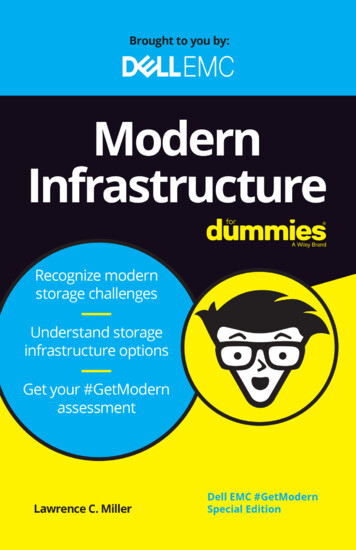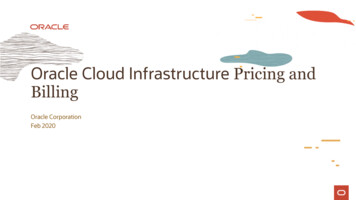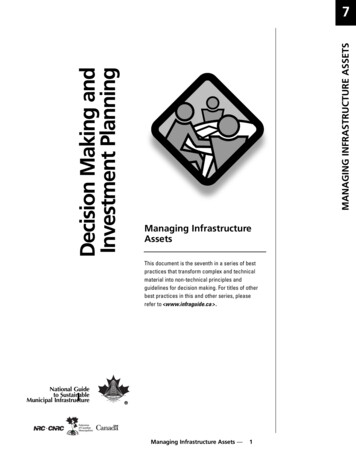
Transcription
Decision Making andInvestment PlanningMANAGING INFRASTRUCTURE ASSETS7Managing InfrastructureAssetsThis document is the seventh in a series of bestpractices that transform complex and technicalmaterial into non-technical principles andguidelines for decision making. For titles of otherbest practices in this and other series, pleaserefer to www.infraguide.ca .National Guideto SustainableMunicipal InfrastructureI Managing Infrastructure Assets —1
Managing Infrastructure AssetsVersion 1.1Publication Date: March 2004Reprint Publication Date: October 2005 2005 Federation of Canadian Municipalities and National Research Council All rights reserved. InfraGuide is a Registered Trademark of the Federation of CanadianMunicipalities (FCM), Ottawa, Ontario.ISBN 1–897094–58–2The contents of this publication are presented in good faith and are intended as generalguidance on matters of interest only. The publisher, the authors, and the organizations towhich the authors belong make no representations or warranties, either expressed orimplied, as to the completeness or accuracy of the contents. All information is presentedon the condition that the persons receiving it will make their own determinations as to thesuitability of using the information for their own purposes and on the understanding that theinformation is not a substitute for specific technical or professional advice or services. In noevent will the publisher, the authors or the organizations to which the authors belong, beresponsible or liable for damages of any nature or kind whatsoever resulting from the useof, or reliance on, the contents of this publication.2Managing Infrastructure Assets — October 2005
IntroductionINTRODUCTIONInfraGuide—InfraGuide —Innovations and Best Practices Why Canada Needs InfraGuideA Knowledge Network of ExcellenceCanadian municipalities spend 12 to 15 billionInfraGuide’s creation is made possible throughannually on infrastructure but it never seems to be 12.5 million from Infrastructure Canada, in-kindenough. Existing infrastructure is ageing while demandcontributions from various facets of the industry,grows for more and better roads, and improved watertechnical resources, the collaborative effort ofand sewer systems responding both to highermunicipal practitioners, researchers and otherstandards of safety, health and environmentalexperts, and a host of volunteers throughout theprotection as well as population growth. The solutioncountry. By gathering and synthesizing the bestis to change the way weCanadian experienceplan, design and manageand knowledge,infrastructure. Only byInfraGuidedoing so can municipalitieshelps municipalities getmeet new demands withinevery dollar they spend on infrastructure—whileframework, while preserving our quality of life.being mindful of the social and environmentalimplications of their decisions.Municipal Infrastructure (InfraGuide) seeks toVolunteer technical committees and working groups—accomplish.with the assistance of consultants and otherIn 2001, the federal government, through itsInfrastructure Canada Program (IC) and the NationalResearch Council (NRC), joined forces with theFederation of Canadian Municipalities (FCM) to createthe National Guide to Sustainable MunicipalInfrastructure (InfraGuide). InfraGuide is both a new,national network of people and a growing collection ofpublished best practice documents for use by decisionmakers and technical personnel in the public andprivate sectors. Based on Canadian experience andresearch, the reports set out the best practices tosupport sustainable municipal infrastructure decisionsand actions in six key areas: municipal roads andBest Practicesthe maximum return ona fiscally responsible and environmentally sustainableThis is what the National Guide to SustainableInnovations andstakeholders—are responsible for the research andpublication of the best practices. This is a system ofshared knowledge, shared responsibility and sharedbenefits. We urge you to become a part of theInfraGuide Network of Excellence. Whether you area municipal plant operator, a planner or a municipalcouncillor, your input is critical to the quality ofour work.Please join us.Contact InfraGuide toll-free at 1-866-330-3350 orvisit our Web site at www.infraguide.ca for moreinformation. We look forward to working with you.sidewalks, potable water, storm and wastewater,decision making and investment planning,environmental protocols, and transit. The bestpractices are available on-line and in hard copy.Managing Infrastructure Assets — October 20053
The InfraGuide Best Practices FocusDecision Making and Investment PlanningElected officials and senior municipal administrators need a framework forarticulating the value of infrastructure planning and maintenance, whilebalancing social, environmental and economic factors. Decision-makingand investment planning best practices transform complex and technicalmaterial into non-technical principles and guidelines for decision making,and facilitate the realization of adequate funding over the life cycle ofthe infrastructure. Examples include protocols for determining costs andbenefits associated with desired levels of service; and strategicbenchmarks, indicators or reference points for investment policyand planning decisions.Potable WaterEnvironmental ProtocolsIn keeping with the adage “out of sight, out ofmind”, the water distribution system has beenneglected in many municipalities. Potable waterbest practices address various approaches toenhance a municipality’s or water utility's abilityto manage drinking water delivery in a way thatensures public health and safety at best value andon a sustainable basis. The up-to-date technicalapproaches and practices set out on key priorityissues will assist municipalities and utilities in bothdecision making and best-in-class engineeringand operational techniques. Issues such as wateraccountability, water use and loss, deteriorationand inspection of distribution systems, renewalplanning and technologies for rehabilitation ofpotable water systems and water quality in thedistribution systems are examined.Environmental protocols focus on the interactionof natural systems and their effects on humanquality of life in relation to municipalinfrastructure delivery. Environmental elementsand systems include land (including flora), water,air (including noise and light) and soil. Examplepractices include how to factor in environmentalconsiderations in establishing the desired levelof municipal infrastructure service; anddefinition of local environmental conditions,challenges and opportunities with respect tomunicipal infrastructure.Storm and WastewaterTransitAgeing buried infrastructure, diminishing financialresources, stricter legislation for effluents,increasing public awareness of environmentalimpacts due to wastewater and contaminatedstormwater are challenges that municipalitieshave to deal with. Storm and wastewater bestpractices deal with buried linear infrastructure aswell as end of pipe treatment and managementissues. Examples include ways to control andreduce inflow and infiltration; how to securerelevant and consistent data sets; how to inspectand assess condition and performance ofcollections systems; treatment plant optimization;and management of biosolids.Urbanization places pressure on an eroding,ageing infrastructure, and raises concerns aboutdeclining air and water quality. Transit systemscontribute to reducing traffic gridlock andimproving road safety. Transit best practicesaddress the need to improve supply, influencedemand and make operational improvementswith the least environmental impact, whilemeeting social and business needs.Municipal Roads and SidewalksSound decision making and preventive maintenance are essentialto managing municipal pavement infrastructure cost effectively.Municipal roads and sidewalks best practices address two priorities:front-end planning and decision making to identify and managepavement infrastructures as a component of the infrastructuresystem; and a preventive approach to slow the deterioration ofexisting roadways. Example topics include timely preventativemaintenance of municipal roads; construction and rehabilitation ofutility boxes; and progressive improvement of asphalt and concretepavement repair practices.4Managing Infrastructure Assets — October 2005
TABLE OF CONTENTSAcknowledgements . . . . . . . . . . . . . . . . . . . . . 7Table of Contents3.33.3.1 How Is AchievementAssessed? (Obectives) . . . . . .21Executive Summary. . . . . . . . . . . . . . . . . . . . . . 91. General . . . . . . . . . . . . . . . . . . . . . . . . . . . . 111.1Introduction . . . . . . . . . . . . . . . . . . . . .111.2Purpose and Scope . . . . . . . . . . . . . .111.3How to Use This Document . . . . . . .121.4Glossary . . . . . . . . . . . . . . . . . . . . . . . .123.3.2 How Are Funding LimitationsDealt With? (Priorities) . . . . . .223.3.3 What Do You Have andWhere Is It? (Inventory) . . . . .223.3.4 What Is It Worth? (Costs,Replacement Rates) . . . . . . . . .222. Rationale . . . . . . . . . . . . . . . . . . . . . . . . . . . 152.1Essential Elements . . . . . . . . . . . . . . .203.3.5 What Is Its Condition andExpected Remaining ServiceLife? (Conditions andCapability Analysis) . . . . . . . . .22Background . . . . . . . . . . . . . . . . . . . . .152.1.1 Ageing Infrastructure . . . . . . .153.3.6 What Is the Level of ServiceExpectation and What Needsto Be Done? (Capital andOperating Plans) . . . . . . . . . . . .232.1.2 Public Demands for HighLevels of Service . . . . . . . . . . .152.1.3 Stringent Regulations . . . . . . .152.1.4 Population Growth/Decline . . .153.3.7 When Do You Need to Do It?(Capital and OperatingPlans) . . . . . . . . . . . . . . . . . . . . .232.1.5 Liability/Risk Management . . .152.1.6 Limited Financial Resources .153.3.8 How Much Will It Cost andWhat Is the AcceptableLevel of Risk? (Capital andOperating Plans) . . . . . . . . . . . .232.1.7 Increased Accountability . . . .162.1.8 Competition . . . . . . . . . . . . . . . .162.1.9 Technology . . . . . . . . . . . . . . . . .163.3.9 How Do You Ensure Long-TermAffordability? (Short- andLong-term Financial Plans) . . .232.1.10 Canadian Initiatives . . . . . . . .162.1.11 International Initiatives . . . . .162.2Benefits . . . . . . . . . . . . . . . . . . . . . . . .162.3Challenges . . . . . . . . . . . . . . . . . . . . . .173.43.4.1 Data Updates . . . . . . . . . . . . . . . 243. Methodology. . . . . . . . . . . . . . . . . . . . . . . . 193.1Key Principles . . . . . . . . . . . . . . . . . . .193.2Asset Management Requirements .19Data Collection (Short- and Long term Financial Plans) . . . . . . . . . . . . 234. Implementation . . . . . . . . . . . . . . . . . . . . . 254.1Implementation Needs . . . . . . . . . . . .253.2.1 Asset Value . . . . . . . . . . . . . . . .194.1.1 People . . . . . . . . . . . . . . . . . . . . .253.2.2 Life Cycle Management . . . . .194.1.2 Information . . . . . . . . . . . . . . . .253.2.3 Sustainability . . . . . . . . . . . . . . .194.1.3 Information Technology . . . . . .253.2.4 Integration of Technical andFinancial Plans . . . . . . . . . . . . .194.1.4 Implementation ofComputerized AssetManagement Systems . . . . . . .263.2.5 Risk Assessment . . . . . . . . . . . .193.2.6 Performance Measurement . .203.2.7 High-Level and DetailedPlans . . . . . . . . . . . . . . . . . . . . . . . . . . .204.1.5 Business Plan . . . . . . . . . . . . . .264.1.6 Implementation Plan . . . . . . . .264.1.7 Challenges . . . . . . . . . . . . . . . . .26Managing Infrastructure Assets — October 20055
Table of Contents4.2Emerging Trends . . . . . . . . . . . . . . . . .275. Evaluation . . . . . . . . . . . . . . . . . . . . . . . . . . 314.2.1 Municipal InfrastructureInvestment Planning . . . . . . . .27Appendix A: SuccessfulImplementations. . . . . . . . . . . . 334.2.2 National Round Table onthe Environment and theEconomy . . . . . . . . . . . . . . . . . . .27References . . . . . . . . . . . . . . . . . . . . . . . . . . . . 394.2.3 Technology Road Map . . . . . . .27FIGURES4.2.4 Benchmarking . . . . . . . . . . . . . .274.2.5 Technology Tools . . . . . . . . . . .284.2.6 Regulations . . . . . . . . . . . . . . . .284.2.7 Public-Private Partnerships . .284.2.8 Continuous Improvement . . . .284.3Application in Small or RemoteMunicipalities . . . . . . . . . . . . . . . . . . .284.3.1 Small Municipalities . . . . . . . . .294.3.2 Remote Municipalities . . . . . . .296Managing Infrastructure Assets — October 2005Figure 2–1: Corporate Strategic Framework forAsset Management . . . . . . . . . . . . . .17Figure 3–1: Asset Management PlanningFramework . . . . . . . . . . . . . . . . . . . . . .21
ACKNOWLEDGEMENTSAcknowledgementsThe dedication of individuals who volunteered theirIn addition, the Decision-Making and Investmenttime and expertise in the interest of the National GuidePlanning Technical Committee would like to thank theto Sustainable Municipal Infrastructure (InfraGuide) isfollowing individuals for their participation in workingacknowledged and very much appreciated.groups and peer review:This best practice was developed by stakeholdersfrom Canadian municipalities and specialists fromacross Canada, based on a working paper preparedby five consulting firms (R.V. Anderson AssociatesLimited, CH2M HILL Canada, Dillon Consulting, EarthTech, and Stantec Consulting). The following membersof the InfraGuide’s Decision-Making andInvestment Planning Technical Committee providedguidance and direction in the development of this bestpractice. They were assisted by InfraGuideDirectorate staff and by R.V. Anderson AssociatesLimited.Guy CourtnayDillon Consulting Ltd., Toronto, OntarioGerry DavisCity of Hamilton, OntarioDoug FloydDelcan Corporation, Vancouver, British ColumbiaDenis GagnonCity of Québec, QuebecRobert ShamessCity of Kitchener, OntarioDana VanierNational Research Council CanadaOttawa, OntarioUmendra Mital, ChairCity of Surrey, British ColumbiaClarke BellingerCH2MHILL, Ottawa, OntarioEd KovacsCity of Cambridge, OntarioLuc LahaieCity of Laval, QuebecBetty Matthews-MaloneCounty of Haldimand, OntarioOsama MoselhiConcordia University, Montréal, QuebecJean-Pierre PierreCity of Clarence-Rockland, OntarioKonrad SiuCity of Edmonton, AlbertaPeter SteblinCity of London, OntarioGeorge TrainorCity Councillor, CharlottetownPrince Edward IslandJeff PotkinsTechnical AdvisorNational Research Council CanadaOttawa, OntarioManaging Infrastructure Assets — October 20057
AcknowledgementsThis and other best practices could not have beendeveloped without the leadership and guidance ofInfraGuide’s Governing Council, the RelationshipInfrastructure Committee, and the MunicipalInfrastructure Committee, whose members are asfollows.Governing Council:Joe AugéGovernment of the Northwest TerritoriesYellowknife, Northwest TerritoriesMike BadhamCity of Regina, SaskatchewanSherif BarakatNational Research Council CanadaOttawa, OntarioBrock CarltonFederation of Canadian MunicipalitiesOttawa, OntarioJim D’OrazioGreater Toronto Sewer and Watermain ContractorsAssociation, Toronto, OntarioDouglas P. FloydDelcan Corporation, Toronto, OntarioDerm FlynnTown of Appleton, Newfoundland and LabradorJohn HodgsonCity of Edmonton, AlbertaJoan Lougheed, CouncillorCity of Burlington, OntarioSaeed MirzaMcGill University, Montréal, QuebecUmendra MitalCity of Surrey, British ColumbiaRené MorencyRégie des installations olympiquesVaughn PaulFirst Nations (Alberta) Technical Services AdvisoryGroup, Edmonton, AlbertaRic RobertshawPublic Works, Region of Peel, Brampton, OntarioDave RudbergCity of Vancouver, British ColumbiaVan SimonsonCity of Saskatoon, SaskatchewanBasil Stewart, MayorCity of Summerside, Prince Edward IslandSerge ThériaultGovernment of New BrunswickFredericton, New Brunswick8Managing Infrastructure Assets — October 2005Tony VarrianoInfrastructure Canada, Ottawa, OntarioAlec WatersAlberta Infrastructure DepartmentEdmonton, AlbertaWally WellsThe Wells Infrastructure Group Inc.Toronto, OntarioMunicipal Infrastructure Committee:Al Cepas,City of Edmonton, AlbertaWayne GreenGreen Management Inc.Mississauga, OntarioHaseen KhanGovernment of Newfoundland and LabradorSt. John’s, Newfoundland and LabradorEd S. KovacsCity of Cambridge, OntarioSaeed MirzaMcGill University, Montréal, QuebecUmendra MitalCity of Surrey, British ColumbiaCarl YatesHalifax Regional Water Commission, Nova ScotiaRelationship Infrastructure Committee:Geoff GreenoughCity of Moncton, New BrunswickJoan Lougheed, CouncillorCity of Burlington, OntarioOsama MoselhiConcordia University, Montréal, QuebecAnne-Marie ParentParent Latreille and AssociatesMontréal, QuebecKonrad SiuCity of Edmonton, AlbertaWally WellsThe Wells Infrastructure Group Inc.Toronto, OntarioFounding Member:Canadian Public Works Association (CPWA)
EXECUTIVE SUMMARYThis document describes the fundamentalconcepts, components, and considerationsinherent in an asset management plan as amunicipal best practice. Asset managementhas been described as ”a systematic processof maintaining, upgrading, and operatingphysical assets cost-effectively. It combinesengineering principles with sound businesspractices and economic theory, and it providestools to facilitate a more organized, logicalapproach to decision-making. Thus assetmanagement provides a framework forhandling both short- and long-range planning“(US, Department of Transport (DOT), 1999).Canadian municipalities are realizing that anasset management plan will be required toaddress the rising costs for, and competingpriorities associated with, infrastructurerenewal programs. An asset management planis also needed to address public demands fora higher level of service, more stringentregulations, population changes, limitedfinancial resources, competition, andtechnology.Benefits Aand ChallengesAsset management provides transparent,rational, and accountable cost-effectivemanagement of municipal infrastructuresystems with best value for money, savingunnecessary cost. In this capacity, assetmanagement could be viewed as a valuemanagement program at strategic and tacticallevels. Specific benefits include: facilitates the establishment andsubsequent implementation of policyobjectives and the related measurement ofperformance; helps in avoiding problems and potentialcrises; provides better and consistent levels ofservice to the public, at less cost; leads to improved and more effectivecommunication with the public;Executive Summary reduces life cycle costs; improves service and performance; allows for better decisions regardingresource allocation; reduces risk to the municipality; leads to more effective communication withratepayers, elected officials, financial ratingorganizations, and regulatory agencies; allows for more accurate financial planning; leads to more efficient data management;and results in positive institutional change.There are several potential challenges inasset management planning. Realizing the promise engendered in anAsset managementhas been describedas ”a systematicprocess ofmaintaining,upgrading, andoperating physicalassets costeffectively.”asset management plan, will be mucheasier if it is situated securely within themunicipality’s strategic and corporatebusiness plan and has the approval ofsenior levels of the municipality. The lack ofa corporate sponsor could result in a lessthan optimum overall corporate strategywith which to support the implementationof an asset management plan. The asset management plan must considerthe overall life cycle costs of providingthe service and be prepared to makeinvestment decisions accordingly.Alternative investment decisions mayresult in increased funding requirements. There are significant challenges associatedwith developing a relevant and up-to-datedatabase of infrastructure inventory, andcondition and capacity information andanalysis.Key PrinciplesAsset management is characterized by severalkey principles, including asset value, life cyclemanagement, long-term affordability, riskmanagement and assessment, performancemeasurement, operational plans, andintegration of technical and financial plans. improves evaluation of return on investment;Managing Infrastructure Assets — October 20059
Executive SummaryTwo complementary approaches are used todevelop an asset management plan, namely, asenior-directed approach and an operationalapproach. The senior-directed approach isused for strategic long-term planning ofpolicies and programs. The operationalapproach is used for short-term capital andoperational planning of projects. Theoperational approach requires a more detailedinventory and condition data than the seniordirected approach.Essential ElementsThe framework for an asset management plancan be described in terms of seven questions.1. What do you have and where is it?(Inventory)2. What is it worth?(Costs/replacement rates)3. What is its condition and expectedremaining service life?(Condition and capability analysis)4. What is the level of service expectation, andwhat needs to be done?(Capital and operating plans)5. When do you need to do it?(Capital and operating plans)Successful ImplementationsThis report summarizes several successfulimplementations of asset management inCanadian municipalities. However, successfulimplementation requires that municipalitiesovercome institutional, technical, and fundingchallenges before they can successfullyimplement asset management. Measures toovercome these challenges include: improved communication; education; training; advance planning; and6. How much will it cost and what is theacceptable level of risk(s)?(Short- and long-term financial plan) information technology.7. How do you ensure long-term affordability?(Short- and long-term financial plan)Finally, an asset management plan should beevaluated to assess its effectiveness. Thiscan be done through several means.This framework is applicable to both thesenior-directed and operational approaches.Implementation NeedsImplementation of an asset management planrequires people, information, and technology.A business plan should be prepared to outlinethe expected costs directly related topreparing and implementing the plan, andthe benefits of implementation.An implementation plan should identify theshort- and long-term objectives of assetmanagement, a work plan, roles andresponsibilities, schedule and budget for10various milestones, and the deliverables.This best practice identifies severalchallenges in implementing an assetmanagement plan successfully, includinginstitutional, technical, and fundingchallenges. Several key initiatives andemerging trends in asset management aredescribed: the Civil Infrastructure SystemsTechnology Road Map, the MunicipalInfrastructure Investment Planning project,benchmarking, technology tools, regulations,public-private partnerships, and continuousimprovement.Managing Infrastructure Assets — October 2005Asset Management Evaluation Monitor the condition of the infrastructureto ensure that an adequate level of serviceis maintained over the long term. For this, areplicable condition rating system should beused. Monitor the performance of theinfrastructure to ensure that an adequatelevel of service is maintained over the longterm and to assess the efficiency andeffectiveness of the municipality. Track unplanned spending on an annualbasis to confirm that the asset managementplan is effective. Implementation of an assetmanagement plan should reduce unplannedspending over a period of years.
1. General1. General1.1 Introduction1.2 Purpose and Scope1.1IntroductionIn the past, most Canadian municipalitiesfocused on expansion of their infrastructure(e.g., roads, bridges, sewers, water mains,and buildings) to support population growth.Now, many municipalities are realizing thatthe cost of renewing ageing infrastructuresis increasing, and these infrastructures haveto be considered as ”assets.“Asset management is not a new concept.It has been widely used for many years in realestate, property management, finance,manufacturing, information technology, andother areas of private industry. However, inthese cases, the assets are usually moreeasily converted into money and have ashorter life expectancy than is the case withmunicipal infrastructure. At the same time,abandoning or eliminating the asset at theend of its life is not typically an option formunicipal infrastructure. Furthermore, privatecompanies are motivated by profit, whereasthe provision and stewardship of basic civilinfrastructure is a fundamental and keyresponsibility of municipalities. Nevertheless,fundamental asset management concepts arestill applicable to municipal infrastructure.Municipal infrastructure requires ongoinginvestment to sustain it. In other words,municipal infrastructure has monetary value,and its components will not last forever.The Federal Highway Administration (US, DOT,1999) described asset management as ”asystematic process of maintaining, upgrading,and operating physical assets cost-effectively.It combines engineering principles with soundbusiness practices and economic theory, andit provides tools to facilitate a more organized,logical approach to decision-making. Thusasset management provides a framework forhandling both short- and long-range planning.“In other words, asset management should helpmunicipalities identify the right amount ofmoney to be spent on the right things, at theright time. Asset management is a ”way ofdoing business,“ not just another programrequiring another new bureaucracy.1.2Purpose and ScopeThis best practice is intended to providemunicipal infrastructure managers, electedofficials, and technical staff with sufficientinformation to recognize the need to developan asset management plan. The rationale forasset management as an intrinsic aspect ofthe municipal strategic and business processwill become apparent. A related objective isthe development of an appreciation amongelected officials of their role as stewards ofinfrastructure assets and the service theseassets provide, now and in the future. It isnot intended to be a guide for the developmentof an asset management plan or for theimplementation of an asset managementsystem.Asset managementis not a newconcept. It hasbeen widely usedfor many years inreal formationtechnology, andother areas ofprivate industry.The report provides an overview of thecomponents of municipal infrastructure assetmanagement planning and its benefits to helpelected officials and senior appointed officialsand administrators realize the importanceof developing and implementing a plancustomized for their own municipalities. Amunicipal infrastructure asset managementplan includes: key principles; essential elements; data collection; implementation needs; operational considerations; successful implementations; and emerging trends.Managing Infrastructure Assets — October 200511
1.31. General1.3 How To Use ThisDocument1.4 GlossaryHow To Use this DocumentSection 2 gives some background on assetmanagement plans as well as the potentialbenefits and risks associated with theirimplementation.Section 3 outlines a framework for an assetmanagement plan.Section 4 presents some considerations forimplementation of an asset management plan.Section 5 describes several measures toevaluate the effectiveness of assetmanagement.InfraGuide has already published severalother best practices relevant to municipalinfrastructure asset management, includingthe following.Developing a Water Distribution SystemRenewal Plan — This document outlines twocomplementary approaches for thedevelopment of a water distribution systemrenewal plan. The senior-directed approachis used for strategic planning of policies andprograms, whereas the operational approachis used for short-term capital planning ofprojects. Both approaches use a commonframework, although they differ in terms ofthe level of detail. Examples are provided toillustrate the application of both approaches.A renewal plan is a key component of an assetmanagement plan.Municipal Infrastructure ReinvestmentParameters and Their Applications — Thisdocument describes four practices that can beused to achieve adequate levels of investmentin municipal infrastructure. These methodsinclude an infrastructure asset report model,high-level parameters, detailed levelparameters, and improved communication.Planning and Defining MunicipalInfrastructure Needs — This documentpresents five practices to assist with planningand defining municipal infrastructure needs,namely, strategic planning, informationmanagement, building public support andacceptance, exploring new and innovativemethods for continuous improvement, andprioritization models.12Managing Infrastructure Assets — October 2005An Integrated Approach to Assessment andEvaluation of Municipal Road, Sewer, andWater Networks — This document outlinesthe need for integrated renewal planning ofmunicipal road, sewer, and water systemsat a network level. It describes a five-stepprocedure for assessment and evaluation ofmunicipal infrastructure, including inventory,investigation, condition assessment,performance evaluation, and renewalplanning.Additional best practice reports and otherdocuments related to this subject areavailable from the InfraGuide Web site www.infraguide.gc.ca .1.4GlossaryAsset — A physical component of a facility,which has value, enables services to beprovided and has an economic life of greaterthan 12 months. Dynamic assets have somemoving parts, while passive assets have none.Asset management — The combination ofmanagement, financial, economic,engineering, operational and other practicesapplied to physical assets with the objective ofproviding the required level of service in themost cost-effective manner.Asset management plan — A plan developedfor the management of one or moreinfrastruct
of municipal infrastructure service; and definition of local environmental conditions, challenges and opportunities with respect to municipal infrastructure. Transit . Urbanization places pressure on an eroding, ageing infrastructure, and raises concerns about declining air and water quality. Transit systems contribute to reducing traffic .

